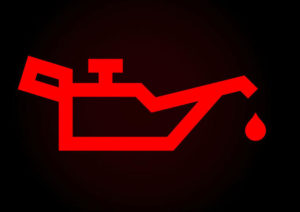
If the engine oil pressure warning light is on, it may mean your engine has lost normal oil pressure. STOP driving immediately and turn the engine off. The engine can be severely damaged if oil pressure is lost.
Possible Causes of Low Oil Pressure Warning Light:
A low oil level (check the dipstick), bad oil pump, or defective oil pressure sending unit, oil pressure gauge or warning light switch.
Oil Pressure Warning Light Diagnosis
Oil leaks are a common cause of oil consumption and a low oil level in the engine. Oil leaks can occur at the valve cover, oil pan or timing cover gaskets, or the front and rear crankshaft oil seals. Inspect the top, sides and bottom of the engine for signs of oil leakage. Look for greasy stains, heavy accumulations of grease, or oil dripping on the ground. The higher the miles on the engine, the more likely the gaskets and seals may be leaking. If your engine is leaking oil because of a bad gasket or seal, the leaky gasket or seal should be replaced.First, determine if the oil is full or low by checking the dipstick. NOTE: On some engines, there is an oil level sensor in the engine’s oil pan that will turn on the oil warning light if the oil level is low. If the dipstick shows a low oil level (the oil level is at or below the ADD line, or no oil can be seen on the dipstick), your engine may be leaking oil, burning oil or both.
If the outside of the engine is clean and there are no obvious oil leaks, and the oil level is low, the engine is probably burning oil due to worn piston rings, valve guides or valve guide seals. This may be the result of high mileage wear or neglect. Either way, this kind of oil consumption problem is expensive to fix because it may require rebuilding or replacing the engine. NOTE: On many engines, replacing the valve guide seals will significantly reduce oil burning if the original guides and seals are worn.
If the oil usage is not too severe (say less than one quart of oil every 1000 miles), check the dipstick often and keep adding oil as needed. If the engine is using a lot of oil (say more than a quart every 500 miles), check the dipstick constantly and keep plenty of oil onhand. An engine that is burning a lot of oil is worn out and will soon have to be overhauled or replaced.
Bad Oil Pump?
If the oil level is between ADD and FULL, and the engine was making noise when it was running, the problem may be a bad oil pump. DO NOT run the engine until the problem can be repaired. Oil pressure can be checked by attaching a pressure gauge to the engine where the oil pressure sending unit is attached. If oil pressure is within specifications (typically 10 psi for every 1000 rpm) the oil pump is okay. If pressure is less than specifications, the oil pump may be worn, or the engine bearings may be worn.
If the oil level is between ADD and FULL, and the engine was running normally (no noise) after the oil pressure warning light came on, the problem may be a defective oil pressure sending unit, oil pressure gauge or warning light switch. You can probably start the engine and drive the vehicle home or to a shop for repairs. But if the engine starts to become noisy, STOP and shut off the engine.
Low Oil Pressure Fixes
If the oil level is low, add oil to the engine to bring the level up to the FULL mark on the dipstick. DO NOT overfill the crankcase. Use the type of oil viscosity specified in the vehicle owners manual.
If the oil pressure gauge reading remains low or the oil pressure warning light remains on, remove the oil pressure sending unit on the engine and connect a pressure gauge directly to the engine. Start the engine to see if the pump is generating adequate pressure. If pressure is normal (about 10 PSI for every 1000 RPMs of engine speed, the problem is not a bad oil pump, but a faulty oil pressure sending unit. Replace the oil sending unit.
If you do not have a pressure gauge for testing oil pressure, try replacing the oil pressure sending unit with a new one. If the oil pressure warning light goes out or the gauge reading is now normal, you have fixed the problem. But if the warning light or low gauge reading continues, the problem is likely a bad oil pump.
If the oil pump is bad (does not produce adequate pressure), the oil pump will have to be replaced. On many engines, the oil pump is located inside the oil pan on the bottom of the engine. The pan must be removed to replace the pump. This may require raising the engine and/or removing steering or suspension components that are in the way so the pan can be removed. On other engines, the oil pump is located inside the timing cover on the front of the engine. Disassembly requires removing most of the components on the front of the engine to access the pump. This type of pump is much more difficult and time consuming to replace.
If oil pressure is low because of worn engine bearings, the crankshaft bearings will have to be replaced. This usually requires overhauling or replacing the engine.
SOURCE: aa1car
